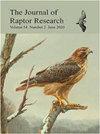Winter Distribution of Golden Eagles in the Eastern USA
IF 1.2
4区 生物学
Q2 ORNITHOLOGY
引用次数: 0
Abstract
ABSTRACT. Golden Eagles (Aquila chrysaetos) have a Holarctic distribution, but some details of that overall distribution are poorly understood, including parts of the range in eastern North America. Recent studies in the region suggest that Golden Eagles may be more widely distributed than previously recognized. For species specific conservation efforts to be effective, an understanding of the distribution of the species is essential. Thus, the goal of this study was to map the winter distribution of Golden Eagles in the eastern half of the USA. To accomplish this, we reviewed and compiled 11,981 Golden Eagle records from eight data sources, including literature and ornithology records, community science data, survey data, and telemetry data. We found that Golden Eagles were observed in winter in each of the 31 states that lie completely east of the 100th meridian and in 1244 of the 2045 counties (61%) in those states. The proportion of counties with records varied by physiographic province, with higher proportions in physiographic provinces with more rugged terrain and greater forest cover. Our study shows that Golden Eagles are more widely distributed during winter in eastern USA states than was previously recognized. This work provides an important foundation for future management and research at a time when threats to this species are expanding rapidly on the landscape. RESUMEN. Si bien Aquila chrysaetos tiene una distribución holártica, algunos aspectos de su distribución en el este de América del Norte no son del todo claros. Estudios recientes en la región sugieren que su distribución puede ser más amplia que la distribución previamente reconocida. Para que los esfuerzos de conservación para una especie en particular sean efectivos, es esencial comprender su distribución. Así, el objetivo de este estudio fue elaborar un mapa de la distribución invernal de A. chrysaetos en la mitad oriental de EEUU. Para esto, revisamos y compilamos 11,981 registros de A. chrysaetos provenientes de ocho fuentes de datos, incluyendo literatura y registros ornitológicos, datos de ciencia comunitaria, datos de censos y datos de telemetría. Encontramos que A. chrysaetos fue observada en invierno en cada uno de los 31 estados que se encuentran completamente al este del meridiano 100 y en 1244 de los 2045 condados (61%) de estos estados. La proporción de condados con registros varió según la provincia fisiográfica, con proporciones más altas en provincias fisiográficas con terreno más accidentado y mayor cobertura forestal. Nuestro estudio muestra que la distribución de A. chrysaetos durante el invierno en los estados del este de EEUU es efectivamente más amplia que la previamente reconocida. Este trabajo proporciona una base importante para la gestión e investigación futura en un momento en que las amenazas para esta especie se están expandiendo rápidamente en el paisaje. [Traducción del equipo editorial]金雕在美国东部的冬季分布情况
摘要:金雕(Aquila chrysaetos)分布在全北极地区,但人们对其整体分布的一些细节知之甚少,包括北美东部的部分地区。最近在该地区的研究表明,金雕的分布范围可能比以前认识到的更广。要使针对特定物种的保护工作有效,了解该物种的分布情况至关重要。因此,本研究的目标是绘制金雕在美国东半部的冬季分布图。为此,我们从文献和鸟类学记录、社区科学数据、调查数据和遥测数据等八个数据源中查阅并汇编了 11981 条金雕记录。我们发现,在完全位于 100 度经线以东的 31 个州中的每个州,以及这些州的 2045 个县中的 1244 个县(61%),冬季都能观察到金雕。有记录的县的比例因地貌省份而异,地形更崎岖、森林覆盖率更高的地貌省份的比例更高。我们的研究表明,金雕在美国东部各州冬季的分布范围比以前认识到的更广。在该物种面临的威胁迅速扩大的情况下,这项工作为未来的管理和研究奠定了重要基础。ABSTRACT Aquila chrysaetos 虽然分布在全北极地区,但其在北美东部的分布情况并不完全清楚。最近在该地区的研究表明,它的分布范围可能比以前认识到的更广。要想有效地保护某一物种,就必须了解其分布情况。因此,本研究的目的是绘制 A. chrysaetos 在美国东半部的冬季分布图。为此,我们从鸟类学文献和记录、群落科学数据、普查数据和遥测数据等八个数据源中查阅并整理了 11981 条 A. chrysaetos 的记录。我们发现,在完全位于 100 度经线以东的 31 个州中的每个州,以及这些州的 2045 个县中的 1244 个县(61%),冬季都能观测到 A. Chrysaetos。有记录的县的比例因地貌省份而异,地形更崎岖、森林覆盖率更高的地貌省份的比例更高。我们的研究表明,A. chrysaetos 冬季在美国东部各州的分布范围确实比以前认识到的要广。在该物种面临的威胁迅速扩大到整个地貌的时候,这项工作为未来的管理和研究提供了重要依据。[由编辑团队翻译]。
本文章由计算机程序翻译,如有差异,请以英文原文为准。
求助全文
约1分钟内获得全文
求助全文
来源期刊

Journal of Raptor Research
生物-鸟类学
CiteScore
2.30
自引率
17.60%
发文量
61
审稿时长
>12 weeks
期刊介绍:
The Journal of Raptor Research (JRR) is an international scientific journal dedicated entirely to the dissemination of information about birds of prey. Established in 1967, JRR has published peer-reviewed research on raptor ecology, behavior, life history, conservation, and techniques. JRR is available quarterly to members in electronic and paper format.
 求助内容:
求助内容: 应助结果提醒方式:
应助结果提醒方式:


